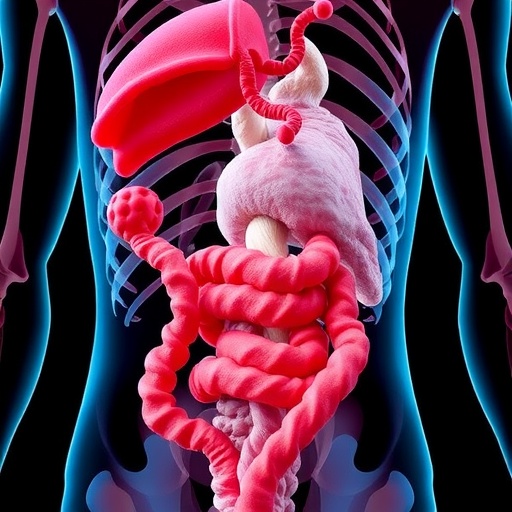In the latest edition of the Diabetes Therapy journal, researchers explore an intriguing and complex condition that straddles the boundaries of both autoimmune dysfunction and gastrointestinal disorder. The article by Bell and Jerkins specifically centers on a case study involving pseudoascites, a medical condition that mimics the appearance of ascites, but is not caused by the pathological accumulation of fluid in the peritoneal cavity. This situation can create diagnostic challenges, particularly for individuals already diagnosed with Type 1 diabetes and coexisting celiac disease.
Type 1 diabetes is well-known for its autoimmune origins, where the body’s immune system mistakenly attacks insulin-producing beta cells in the pancreas. Celiac disease, on the other hand, is characterized by an inappropriate immune response to gluten, resulting in damage to the small intestine. The intersection of these two chronic conditions can lead to a cascade of symptoms that complicate clinical management and patient quality of life. In the case discussed by the authors, the interplay between these diseases presents unique challenges that warrant in-depth investigation.
The case in question involved a female patient already diagnosed with Type 1 diabetes who began to exhibit signs concerning for pseudoascites. This condition presents as an accumulation of fluid in the abdominal cavity but lacks the typical underlying causes such as liver cirrhosis or malignancy. Instead, pseudoascites in this patient was linked to the malabsorption issues commonly associated with celiac disease. Malabsorption can result in an imbalance of fluid dynamics in the body, leading to the misleading signs typically associated with genuine ascites. This distinction highlights the importance of accurate diagnosis in patients with complex autoimmune conditions.
In the clinical setting, the differentiation between pseudoascites and true ascites is crucial. Diagnostic imaging, such as ultrasound, often reveals fluid in the abdomen, but further evaluation is necessary to assess the underlying etiology. In this case, further investigation showed no signs of malignancy or liver dysfunction, steering the clinicians towards alternative diagnoses related to the patient’s existing celiac disease. This aspect of diagnostics emphasizes how a comprehensive understanding of a patient’s medical history can influence clinical decisions and treatment pathways.
One intriguing facet of this research is the implications it raises for clinical practice. It is not merely the presence of diabetes or celiac disease that warrants attention; rather, it is the understanding of how these conditions can interplay in unexpected ways, manifesting in symptoms that can baffle even experienced healthcare professionals. The need for heightened awareness of such complications reflects broader themes in chronic disease management, urging clinicians to maintain a holistic view of their patients’ health.
Treatment options for pseudoascites, particularly when caused by celiac disease, largely focus on dietary management. The cornerstone of therapy involves the strict adherence to a gluten-free diet, which serves to reduce inflammation in the intestines and allow for proper nutrient absorption. As the patient improves and malabsorption issues resolve, symptoms associated with pseudoascites can diminish significantly. This approach underscores the pivotal role nutrition plays in managing autoimmune conditions and the importance of multidisciplinary care models that integrate dietitians alongside medical professionals.
The authors also highlight the need for ongoing research in this area to better understand the mechanisms that drive the development of such atypical manifestations of celiac disease. Current literature primarily focuses on gastrointestinal symptoms; however, this study opens the door to a wider array of complications that may arise in the context of coexisting conditions. As the medical community advances its understanding of disease interactions, future studies should aim to unravel the complex web of pathophysiology that links diabetes and celiac disease.
In conclusion, this case study provides significant insight into the complexities of managing coexisting autoimmune disorders. It serves as a reminder that even experienced clinicians must constantly evolve their understanding of disease interaction and be alert to the myriad ways in which symptoms can present. For patients with Type 1 diabetes and celiac disease, recognizing and appropriately diagnosing pseudoascites could lead to more effective management strategies and improved quality of life. With continuing research, we can hope for more refined approaches that address the unique challenges posed by these overlapping health issues.
Understanding the intricate relationship between autoimmune diseases is essential for advancing medical knowledge and improving patient outcomes. As healthcare evolves, the importance of accurate diagnosis and personalized treatment plans continues to gain recognition within the broader medical context.
Ultimately, case reports such as this play a critical role in the medical literature, fueling discussions about patient care, diagnostics, and treatment protocols. The story of this patient encapsulates not only the difficulties faced by those with chronic illnesses but also the promising pathways that can emerge when research and clinical expertise align.
Subject of Research: Pseudoascites due to Celiac Disease in Type 1 Diabetes
Article Title: Pseudoascites Due to Celiac Disease in a Patient with Type 1 Diabetes
Article References:
Bell, D.S.H., Jerkins, T. Pseudoascites Due to Celiac Disease in a Patient with Type 1 Diabetes.
Diabetes Ther 16, 1525–1528 (2025). https://doi.org/10.1007/s13300-025-01744-5
Image Credits: AI Generated
DOI: https://doi.org/10.1007/s13300-025-01744-5
Keywords: Type 1 Diabetes, Celiac Disease, Pseudoascites, Autoimmune Disorders, Malabsorption, Diet Management, Chronic Illness, Patient Care, Gastrointestinal Disorders.




